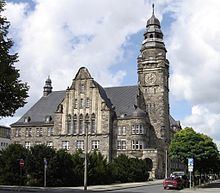Time zone CET/CEST (UTC+1/+2) Area 50.44 km² Local time Tuesday 11:57 PM | Elevation 25 m (82 ft) Postal codes 19322 Population 19,023 (31 Dec 2008) Postal code 19322 | |
 | ||
Weather 8°C, Wind NE at 5 km/h, 84% Humidity | ||
Wittenberge ( [ˌvɪtənˈbɛɐ̯ɡə]) is a town of eighteen thousand people on the middle Elbe in the district of Prignitz, Brandenburg, Germany.
Contents
- Map of 19322 Wittenberge Germany
- Geography
- History
- Mayor
- Twin towns Sister cities
- Notable residents
- References
Map of 19322 Wittenberge, Germany
Geography
Wittenberge is situated at the right (north-eastern) bank of the middle Elbe at its confluence with the Stepenitz and Karthane in the German district of Prignitz. Within the same district, the town borders the Ämter Lenzen-Elbtalaue and Bad Wilsnack/Weisen as well as the district capital Perleberg. The Verbandsgemeinde Seehausen (Altmark) in the district of Stendal, Saxony-Anhalt, lies on the opposite side of the Elbe.
History
The site was marked out in 1239 at Wendischwalde and in 1300 the Saxon king, Otto I, established the settlement. It grew slowly but steadily. The town castle (1669) survives as the town museum but it suffered fires in 1686 and 1757, and floods from the Elbe in 1709 and 1761. Nevertheless, because of its position, it prospered from the opening of the Berlin–Hamburg steamship traffic. By 1823 milling, processing and refining of foodstuffs were important industries. In 1846 the railway came and a silk factory was built, followed by a chemical factory in 1849. The Reichsbahn railway workshops were established in 1875 and the world-famous Singer Sewing Machine Company set up there in 1903. By 1914 the Rathaus was built.
From August 15, 1942 until February 17, 1945 a concentration camp was established in Wittenberge. The camp was a subcamp to the Neuengamme concentration camp.
Between the wars much architecture characteristic of the period was built in the form of workers' housing for the rapidly increased population. It suffered as most German towns did during WW II. Only the railway workshops remain as significant employers of the old industries but the large, skilled workforce remains for the newer industries of precision engineering and applied chemistry.
Mayor
Oliver Hermann was reelected in 2016 with 94,8 % of the vote.
Twin towns — Sister cities
Wittenberge is twinned with:
